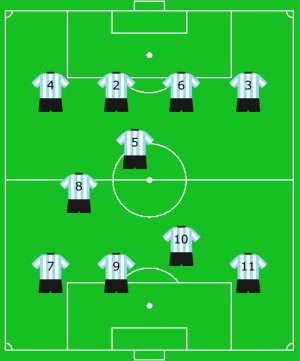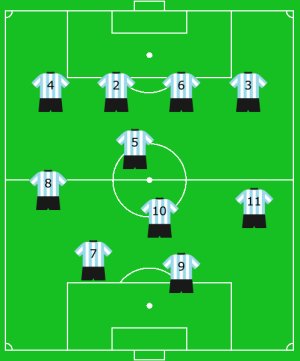Recently, we examined how the ‘classic’ English numbering system came into being through a series of gradual changes. Different methods evolved in different countries, however, and we shall endeavour to show how this happened, if you can cope with the unfortunate jpeg compression that comes from having a rudimentary skill-level with graphics programs (MS Paint and Paint Shop Pro 7, in case you’re curious).
If you’re on this site, you probably have more than a passing interest in numbers and therefore it’s likely you have wondered more than once why South American teams tend to have the number 5 in midfield. For Argentina, for example, Fernando Redondo, Esteban Cambiasso, Javier Mascherano and Fernando Gago have all been what is known as ‘el volante’ or ‘the rudder’.
To find out, we have to go back to the W-M. In the 2-3-5, everybody was numbered the same 2 and 3 in defence, 4,5 and 6 the half-backs and 7-11 across the forward line. With the change to three in defence, however, there was no set in formula. Where the number 5 dropped back between the full-backs in England, in Argentina it was the right-half who now operated as a right-back, with the other two shunted across.
When a four-man defence was adopted, as in Britain it was the number 6 who became a centre-back, but here he partnered the number 2 with 3 moving across to left-back. Number 8 became a midfielder while 10 withdrew slightly from the attack. Eventually, this would become a 4-3-3, with 5, 8 and 10 in midfield.
Later, the number 11 became the left-midfielder with 7 partnering 9 up front, though playing in more of a withdrawn role. This is the numbering style that Argentina have used more or less to the present day. Incidentally, it’s not far off what Liverpool had in their pomp either, but’s for another blog.




Hnnnngggg. This really is too good. I had never thought about the patterns, or that there could be a specific system in place here. Immediately I think of Claudio Lopez wearing #7 in 1998, for example, and things start to make sense. Brilliant.
LikeLike
This of course went to pot when Argentina allocated squad numbers aplabetically in 78 and 82.
LikeLike
I love that someone is writing about this. Does the Argentine method also apply to Brazil? Their recent national teams have tended to use numbers 2-3-4-6 across the defence, with number 5 in midfield (Cerezo, Alemao, Mauro Silva, Cesar Sampaio, etc). Their forwards have also often worn 7 and 9 (Muller and Careca in ’86) or 7 and 11 (Bebeto and Romario in ’94).
LikeLike
Hi James,
Thanks for the comment. The Brazilian way will be featured in a post of its own, hopefully next week.
LikeLike